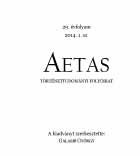A rejtjelezés technológiájának használata Magyarországon az 1700 körüli években
The technology of cryptography in Hungary around 1700
Author(s): Benedek LángSubject(s): History
Published by: AETAS Könyv- és Lapkiadó Egyesület
Summary/Abstract: Sixteenth and seventeenth century ciphered messages are rich information resources of their age. The historian can get close to the attitude of the people involved, to their notion of secret and to the details of their use of technology. What was the relationship of – often civilian – users to the technology they used: did they understand how it worked, did they realize its potentials? How much did they trust that the coded texts will remain secret? To what extent were the people involved in the political and military conflicts aware that their ciphered letters may be deciphered? To what extent were the potentials of a code exploited, to what extent did they endanger the security of information with their carelessness? What typical mistakes did they make and what kind of misunderstandings resulted from these? Were they familiar with the decoding technology of the enemy? Did they make efforts to protect a coding method from being discovered? Did they change their codes often enough? Was any given political player careful enough to use different codes with their different corresponding partners? Who did the ciphering, the head chancellor or the prince himself? And who did the deciphering? Can we reconstruct with the help of the sources what methods were used to break a code? The article offers a systematic analysis of the use of cipher systems and enciphered messages survived from the Hungarian history around 1700.
Journal: AETAS - Történettudományi folyóirat
- Issue Year: 2014
- Issue No: 1
- Page Range: 86-111
- Page Count: 26
- Language: Hungarian

